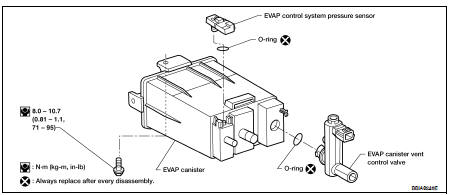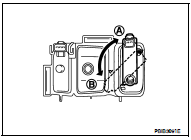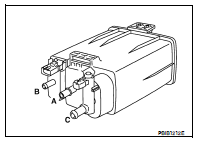Nissan Altima (L32) 2007-2012 Service Manual: On-vehicle repair
EVAP CANISTER
Exploded View
Removal and Installation
REMOVAL
1. Lift up the vehicle.
2. Remove EVAP canister fixing bolt.
3. Remove EVAP canister.
NOTE:
The EVAP canister vent control valve and EVAP canister system pressure sensor
can be removed without
removing the EVAP canister.
INSTALLATION
Install in the reverse order of removal.
NOTE:
Tighten EVAP canister fixing bolt to the specified torque.
DISASSEMBLY
1. Turn EVAP canister vent control valve counterclockwise.
A : Lock
B : Unlock
2. Remove the EVAP canister vent control valve.
ASSEMBLY
Assemble in the reverse order of disassembly.
CAUTION:
Always replace O-ring with a new one.
Inspection
Check EVAP canister as follows:
1. Block port (B).
2. Blow air into port (A) and check that it flows freely out of port (C).
3. Release blocked port (B).
4. Apply vacuum pressure to port (B) and check that vacuum pressure
exists at the ports (A) and (C).
5. Block port (A) and (B).
6. Apply pressure to port (C) and check that there is no leakage.
Inspection
CAUTION:
• Do not use compressed air or a high pressure pump.
• Do not exceed 4.12 kPa (0.042 kg/cm2, 0.6 psi) of pressure in EVAP system.
NOTE:
• Do not start engine.
• I ...
Idle Speed
*: Under the following conditions
• A/C switch: OFF
• Electric load: OFF (Lights, heater fan & rear window defogger)
• Steering wheel: Kept in straight-ahead position
Igni ...
Other materials: Towing your vehicle
When towing your vehicle, all State (Provincial
in Canada) and local regulations for
towing must be followed. Incorrect towing
equipment could damage your vehicle.
Towing instructions are available from a
NISSAN dealer. Local service operators are
generally familiar with the applicable laws
and pro ...
ProPILOT Assist system operation
Steering-wheel-mounted control (left)
Vehicle information display
Steering-wheel-mounted control (right)
ProPILOT Assist switch
The ProPILOT Assist system has the following
two functions:
Intelligent Cruise Control (ICC)
The ICC system can be set to one of two
cruise control modes:
Conve ...
Brakes
If the brakes do not operate properly, have
the brakes checked. It is recommended
that you visit a NISSAN dealer for this
service.
Self-adjusting brakes
Your vehicle is equipped with self-adjusting
brakes.
The front and rear disc-type brakes self-adjust
every time the brake pedal is
applied.
WARNIN ...




 Evap leak check
Evap leak check Service data and specifications
(SDS)
Service data and specifications
(SDS)